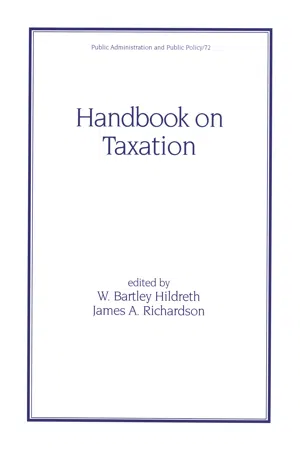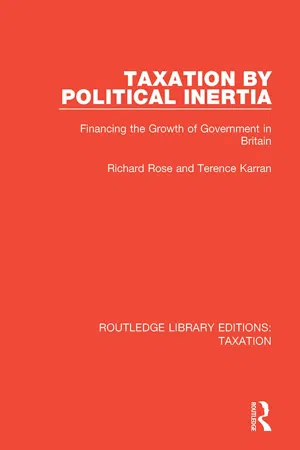Economics
US Tax
US tax refers to the system of taxation imposed by the United States government on the income, profits, and assets of individuals, businesses, and other entities. It includes various types of taxes such as income tax, corporate tax, estate tax, and sales tax. The US tax system is complex and is governed by federal, state, and local tax laws.
Written by Perlego with AI-assistance
8 Key excerpts on "US Tax"
- eBook - ePub
Public Sector Revenue
Principles, Policies and Management
- Alberto Asquer(Author)
- 2017(Publication Date)
- Routledge(Publisher)
2 Taxation Principles, types and effectsPrinciples of taxation
Taxes constitute a main source of public sector revenue in many countries nowadays. While there are many definitions of taxes, especially across different countries, a general understanding of the term is the one provided by the Organisation for Economic Co-operation and Development (OECD, 1996), which defined it as ‘compulsory, unrequited payments to general government’. The meaning of the term ‘unrequited’ is that taxes are paid without any proportionate benefit provided by government to taxpayers. Taxes also include social security contributions, if they are not paid on voluntary basis. Taxes can also include licence fees, although the borderline between taxes and fees (or charges) is not sometimes too straightforward.A distinguishing feature of taxes is that tax obligations arise from the power of the government to impose them on taxpayers. In this sense, taxes are a quintessential manifestation of the sovereignty of states. Governments can require particular categories of citizens (or, in some case, residents irrespective of their citizenship) and private entities (such as companies and charities) to pay taxes to contribute to the running of the government and the implementation of public policies and programmes.Taxes, however, are not arbitrarily decided. As has been long debated within scholarly and political circles, taxes should comply with the fundamental principles of ‘good taxation’. One of the earliest formulations of these principles is found in the writings of Adam Smith (1776), who identified the principles of fairness, certainty, convenience and efficiency.• - eBook - ePub
- Neva Goodwin, Jonathan M. Harris, Julie A. Nelson, Pratistha Joshi Rajkarnikar, Brian Roach, Mariano Torras(Authors)
- 2018(Publication Date)
- Routledge(Publisher)
Fortunately, one need not comprehend the imposing complexity of tax laws to understand the crucial role of taxes in modern societies. Taxation is an important topic for students of economics. Tax policies have important economic consequences, both for a national economy and for particular groups within the economy. Tax policies are often designed with the intention of stimulating economic growth—although economists differ significantly about which tax policies are most effective at achieving this. Taxes can create incentives promoting desirable behavior and disincentives for unwanted behavior. Taxation provides a means to redistribute economic resources toward those with low income or special needs. Taxes provide the revenue needed for important public services such as social security, health care, national defense, and education.Taxation is as much a political issue as an economic issue. Political leaders have used tax policy to promote their agendas by initiating varioUS Tax reforms: decreasing or increasing tax rates, changing the definition of taxable income, creating new taxes on specific products, and so forth. Of course, no one particularly wants to pay taxes. Specific groups, such as corporations, farmers, or retired individuals, exert significant political effort to reduce their share of the tax burden. Tax codes are packed with rules that benefit certain groups of taxpayers while inevitably shifting more of the burden to others.In this chapter, we take a look at taxes and tax policy. First, we consider taxes from a theoretical perspective based on the economic models from earlier chapters. Second, we summarize the different types of taxes, with an emphasis on the United States. Third, we present an international comparison of tax policies. Finally, we address current tax debates, including the distribution of the tax burden among different groups.1 . Economic Theory and Taxes1.1 Taxes in the Supply-and-Demand ModelThe supply-and-demand model we presented in Chapter 3 can be used to gain insights into the effects of taxation on consumers and producers. To incorporate taxes into our model, we consider a per-unit tax on a product or service, referred to as an excise tax - eBook - ePub
- W.Bartley Hildreth(Author)
- 2019(Publication Date)
- Routledge(Publisher)
Taxes are imposed by congressional and legislative fiat. Legislation defines the legal incidence of the tax. The excise tax on tobacco is remitted to the government by tobacco wholesalers, but the true incidence of the tax is borne by any number of people, starting with the consumer, to the retailer distributing the product, to the wholesaler, and to the manufacturer. The legal incidence of a tax is clear, but the economic incidence is much more difficult to identify.Legal incidence is important for administrative purposes, but economic incidence is much more significant for estimating and predicting the impact that the tax might have on the economy. The personal income tax will typically have the same legal and economic incidence; that is, the individual taxpayer will remit the tax to the government and will bear the full burden of the tax. The corporate income tax will be remitted to the government by the corporation, but exactly on whom the burden will fall is subject to debate. The stockholders may absorb some of the tax burden, the corporation’s customers may incur some of the tax burden through higher prices, the corporation’s labor and other such inputs may incur some of the tax burden through lower wages or lower rental rates for property or for leased equipment, or there may be some scattering of the tax burden based on market conditions at the time.Every tax that is not directly imposed on an individual will most probably have an economic incidence that will diverge from the legal incidence of the tax. Taxes on businesses; taxes on energy resources; taxes on tobacco, alcoholic beverages, airlines, telecommunication services, and other such products; import fees; and other taxes that are not directly levied on an individual taxpayer will be shifted if at all possible from the entity legally liable for the tax to some other person involved either with the production or consumption of the product. Exactly on whom the tax burden will ultimately fall depends on market conditions.IV. FEDERAL, STATE, AND LOCAL TAXATION
Taxation is taxation from the perspective of someone having to pay the tax. It does not matter if it is levied by the federal government, the state government, or the local government. A person has to pay the tax. Federal, state, and local governments have selected different types of taxes to finance their respective public services, however. The federal government almost exclusively uses the personal income tax and the payroll tax. These taxes provide about 80 percent of all revenues received by the federal government. Corporate taxes make up about 11 percent of all federal tax collections; excise taxes make up about four percent; and other taxes such as inheritance taxes and import fees, make up about five percent of federal tax collections. Federal tax collections are not highly diversified. - eBook - ePub
- Robert E. Wright, Thomas W. Zeiler(Authors)
- 2014(Publication Date)
- CQ Press(Publisher)
Lost in this discussion, however, have been concerns about simplicity and revenue sufficiency, as the tax system has grown ever more complex since 1986 and the amount of tax revenue collected has fallen well short of government expenditures in recent years. These two factors will no doubt set the stage for the debates that are yet to come.SOURCES OF FEDERAL TAX REVENUEThe federal government in the United States relies on six major types of taxes: the individual income tax, payroll taxes, the corporate income tax, the estate tax, excise taxes, and customs duties and fees.The individual income tax is levied on all sources of income, including wages and salaries; farm, business, and rental income; investment income (including interest, dividends, and capital gains); and other sources. In figuring income tax liability, taxpayers add up all of their sources of income, then subtract a number of adjustments to income (including some education, moving, retirement, and health-related expenses), to yield their adjusted gross income. Taxpayers then subtract either a standard deduction or the total amount of itemized deductions (including medical expenses, state and local income taxes, mortgage interest, charitable donations, and a number of other deductions) and subtract a dollar amount for each exemption that they claim. The result is the taxable income. Finally, taxpayers use a graduated tax schedule in which the marginal tax rate, the tax rate on an additional dollar of income, increases in steps as taxable income increases, to calculate their regular income tax liability. The range of incomes to which a particular marginal tax rate applies is called a tax bracket.Higher income taxpayers must also calculate tax liability in an alternative way by adding back some of the deductions and exemptions and by applying a different rate schedule. If the result of this calculation is higher than their regular income tax liability, they must pay the difference in the form of the Alternative Minimum Tax.Finally, a number of credits are allowed against an individual’s tax liability, including the foreign tax credit, credit for child and dependent care expenses, Child Tax Credit, and the Earned Income Tax Credit (EITC). Some of these credits are payable even if the credit exceeds the taxpayer’s income tax liability.2 - eBook - ePub
Taxation by Political Inertia
Financing the Growth of Government in Britain
- Richard Rose, Terence Karran(Authors)
- 2018(Publication Date)
- Routledge(Publisher)
It is attractive for politicians averse to raising tax rates and broadening the tax base to rely upon economic growth rather than increased tax effort to produce more tax revenue. Each increase in tax effort induces a disproportionate decrease in take-home pay. If a government claims 40 per cent of the national product in taxation, an increase in tax effort to 45 per cent will reduce the private-sector share by 8.3 per cent (that is, from 60 to 55 per cent).The reasons why government favours economic growth are multiple: in a booming economy there is a lot more money to spend, and fewer political difficulties. Moreover, as economic growth is cumulative, in the course of a five-year Parliament an annual growth rate of 2.5 per cent will, by a process of compounding, increase the national product by 16 per cent, and total tax revenue with it.Viewing the economy as a source of tax revenue imposes a one-dimensional perspective upon a multi-dimensional set of activities. Models of the economy designed to illustrate processes important in economic theory often give very little attention to taxation. From a broad economic perspective, issues of prices and wages, investment and growth and foreign exchange rates appear of pervasive importance. Taxation appears only as an intervening variable in the economic system as a whole (Wallis et al., 1984). In many contexts, taxation can be seen as a fiscal instrument used for ulterior, non-revenue ends. Economic activities are reduced by tax laws to such categories as taxable income, or goods liable to value added tax. The flow of income and expenditure through the economy is not the concern of tax authorities, whose primary job is to divert a portion of that flow to the fisc through appropriate administrative means.Certainty and PredictabilityGovernment is concerned with the certainty of revenue and, because budgets are statements about future taxing and spending, about the predictability of revenue. A good tax is not only easy to collect but also will yield an amount of revenue that can be predicted when forecasts are required for the budget in the year ahead. Otherwise the Treasury may make policies based upon misleading assumptions about the public-sector borrowing requirement, the difference between the forecast total expenditure and total revenue. - Holley Ulbrich(Author)
- 2013(Publication Date)
- Routledge(Publisher)
Chapter 17 .Passage contains an image 11 Principles of Taxation I Efficiency and Equity Issues Introduction
Given the need to raise revenues to fund the activities of government, it is the task of economists to figure out how to design a revenue system that is both efficient (minimizing distortions in household and business decisions) and equitable (distributing the burden fairly). Figuring out how to best raise revenue has been a central concern of economists at least since Adam Smith devoted an entire book of The Wealth of Nations (1776) to “the revenue of the sovereign,” including his famous dictum that the taxes one pays should be “proportional to the revenue enjoyed under the protection of the state.” David Ricardo, an important nineteenth-century figure in the history of microeconomic theory, titled his most famous book Principles of Political Economy and Taxation.Until the latter half of the twentieth century, courses in public sector economics were aptly named public finance, because they concentrated so heavily on the revenue side of the public sector to the neglect of the equally important decisions on the expenditure side. Today the balance has shifted, but an understanding of the principles of tax design, both theoretical and applied, is still a central part of the study of public sector economics.Criteria for Evaluating Tax and Revenue SystemsEvery type of tax has positive and negative attributes. Some are more stable than others, or create fewer distortions in household and business decisions. Some are more costly to collect than others. Some are hidden, others highly visible. Some have broad bases, others narrower bases. Certain kinds of taxes are useful for correcting externalities while others may lend themselves to a more equitable distribution of tax liabilities.- eBook - ePub
- William A. Owings, Leslie S. Kaplan(Authors)
- 2019(Publication Date)
- Routledge(Publisher)
Corporate income taxes do have many critics, however. To some it is seen as a “double taxation” system. Others view corporate income taxes as increasing the final cost of goods and services to the end consumer. Still others perceive these taxes as taking money from investors in the form of dividends or stock appreciation, which impacts John and Mary Babyboomer’s retirement portfolio (that includes stocks). The couple may feel better positioned for retirement with lower corporate income taxes, which could result in a higher yield on their investments.The corporate tax issue is complicated and beyond the scope of this text to explain more fully. Suffice it to say that where thriving businesses exist, people are employed and paying income taxes, purchasing and maintaining homes that generate property taxes, and buying goods and services that generate sales taxes. This is a healthy cycle for a local economy, and funding education appropriately keeps that healthy cycle turning.TABLE 5.9 Per Capita State Corporate Net Income Tax Revenue, 2015 (Rank in Parentheses)Source: Morgan, K. & Morgan, S. (2017). State rankings 2017: A statistical view of America . Thousand Oaks, CA: CQ Press, Sage, p. 336.Sumptuary TaxesGovernments impose sumptuary (“sin”) taxes on alcohol and tobacco, for example, to help regulate or limit activities seen to be not in the public’s best interest. Legislatures attempt to regulate these “bad” behaviors by taxing them at varying rates above and beyond the sales tax. “Sin tax”26 revenues generated by alcohol sales attempt to regulate alcohol use by increasing its price (and making it less affordable). Lawmakers reason that if a product’s sale and use are not in the public interest, the additional tax should be used to benefit various other state functions or help remedy the problems the products may have caused.As such, many states received millions of dollars from the 1998 federal court settlements against the tobacco industry. Some states elected to use most of their tobacco settlement monies to fund schools. Other states used the tobacco settlement monies to balance their state budgets by placing these dollars in the state’s general fund. - eBook - ePub
- Joseph A. Pechman(Author)
- 2019(Publication Date)
- Routledge(Publisher)
3 Still others are concerned not only about the equity of the tax system across income classes (vertical equity), but also about its equity among those with the same income (horizontal equity). To a large extent, the debate has centred on the individual income tax, which is the largest source of government revenue in the United States. Even though the other taxes account for more than twice the revenue produced by the individual income tax, the distribution of these taxes by income classes is not generally known. Nor is it generally known if the tax system as a whole has become more or less progressive in recent years. The purpose of this study is to estimate the effect of all US Taxes on the distribution of income, and how this distribution has changed in the last two decades.Major Features of the Study
Although others have made similar estimates, this study is unique in three respects. First, the estimates are based on microunit data files for representative samples of families (referred to as the MERGE files);4 when properly weighted, the samples account for the estimated total income received by family units in the United States. In addition to data on income, the files contain demographic and other economic information about each of the sample units (for example, home-ownership, place of residence, age of family members, and so on). This information is available on computer tape and can be processed quickly and efficiently on an electronic computer, thus permitting estimates to be prepared in more detail than was possible with the previous data-processing techniques.Second, although progress has been made in recent years in improving the methodology of tax analysis, economists still disagree about the incidence of several of the most important taxes in the tax system. Instead of limiting the analysis to one or a few views, estimates were prepared on the basis of eight sets of assumptions that span the range of opinions currently held by most economists (see Table 2.1
Index pages curate the most relevant extracts from our library of academic textbooks. They’ve been created using an in-house natural language model (NLM), each adding context and meaning to key research topics.
Explore more topic indexes
Explore more topic indexes
1 of 6
Explore more topic indexes
1 of 4







